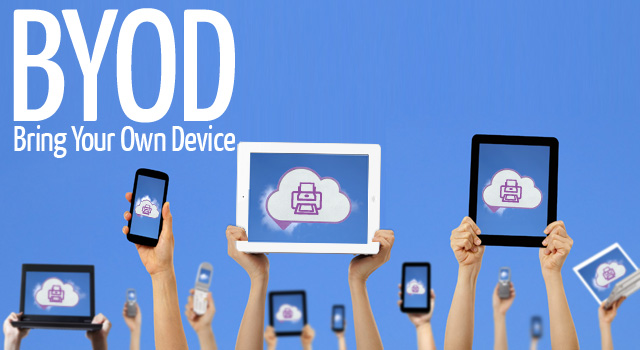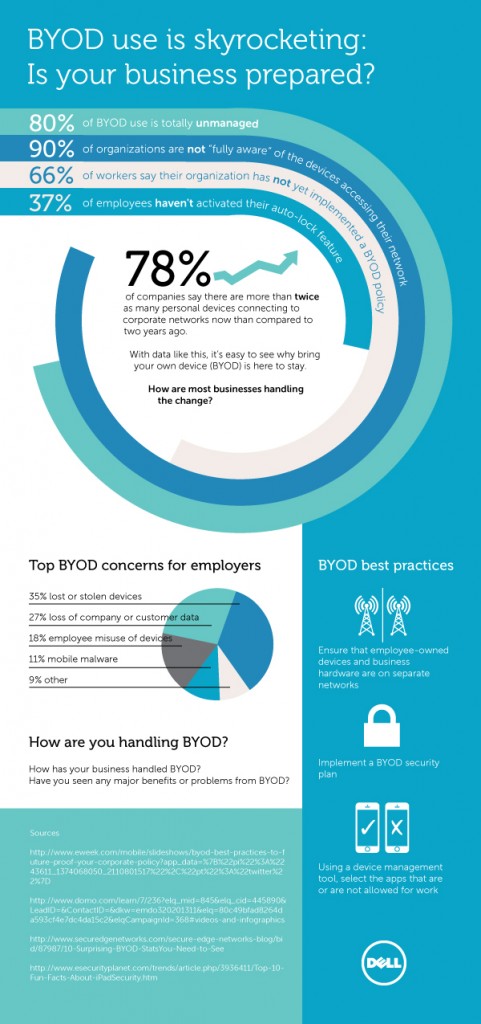 Throughout 2013, Bring Your Own Device (BYOD) policies gained a certain amount of prominence. This was either because companies saw the opportunity to increase cost-saving measures or because employees were finding a way to use consumer technology whether the company allowed it or not. In fact, some estimates say that eight out of 10 employees are using their personal equipment, despite that fact that barely half of their organizations actually condone or prepare for it.
Throughout 2013, Bring Your Own Device (BYOD) policies gained a certain amount of prominence. This was either because companies saw the opportunity to increase cost-saving measures or because employees were finding a way to use consumer technology whether the company allowed it or not. In fact, some estimates say that eight out of 10 employees are using their personal equipment, despite that fact that barely half of their organizations actually condone or prepare for it.
As we move into 2014, BYOD will likely continue to put a strain on the IT departments of these companies, but it will also make the mobile workforce even more productive. In fact, it may be one of the more important trends coming out of the next year.
Gartner, Inc. recently highlighted its top ten emerging technology trends that will have the greatest impact on organizations. According to their findings, they believe that by 2018 70% of employees will conduct their work on their own smart devices. That may be a little way off at the moment, but if the projection holds true, it's something that businesses need to start preparing for sooner rather than later.
Managing Mobility and Diversity
While many organizations reported greater levels of productivity, creativity, and employee satisfaction after implementing a BYOD strategy this year, there are still a number of management challenges that must be addressed as the technology grows and evolves. The sheer number of devices, operating systems, apps, and other programs will continue to grow, employees will demand access to everything from anywhere, and the size of the mobile workforce could conceivably double (or even triple) by 2018.
This kind of growth will continue to strain the staff and budgets of IT departments, but now that the strategy has seen some research and productivity models behind it, there should be fewer pain points moving forward. Companies are starting to learn that they need to set and define clear policies and expectations to ensure the safety and convenience of their networks. However, according to the stats, there are still far more companies that don't understand the implications of unclear policies than those that do.
Mobility has always presented a number of challenges, and it will continue to do so, even with (or perhaps especially with) a BYOD policy. This is another instance where companies can either take the challenge head on to prepare for the unique demands of a growing mobile workforce, or they can try to ignore the issues and hope that it doesn't cause a problem. However, since employees have shown repeatedly that they will just use their own devices, whether they're sanctioned or not, this is something that will have to be addressed at some point.
Expect Even More Devices
As the number of mobile workers continues to grow, so will the number of devices per employee. Between the laptops, smartphones, and tablets, some estimates claim that in many organizations, the employees will average almost three devices each.
New Ways to Use Those Devices
As more devices are brought into the workplace, they're going to come with their own software and tools. After all, there wouldn't be much point in bringing the devices they felt comfortable with if they weren't already loaded with the resources they also enjoyed using. Unfortunately, a lot of these tools and programs will fall into the unapproved category and could cause problems for the IT team if they're not ready for influx.
This is something the organizations will have to address. If an employee feels that they can get better tools for communication, file management, and accessing a private cloud, then that is what they will do. The BYOD policy should either account for this, or the company should consider purchasing these resources and distributing it in a controlled manner.
Ongoing Concerns
Despite the growing acceptance of BYOD, there will still be many privacy and security concerns that organizations will face in 2014. Too much control over an employee's device will likely seem like an invasion of privacy, but too little attention will lead to compliance risks, potential reimbursement costs, and other issues that will cut into the potential productivity gains.
What Should We Expect?
Right now, integrating personal devices into the company's infrastructure is really just about hooking smartphones and tablets up to the email server, calendar system, and possibly a file repository. It's relatively simple and, while it can be a chore to manage and track all the devices, the actual integration isn't necessarily all that complex.
However, going forward into the next year, companies will likely see a lot more developments that target employees who use their personal device at work and home. This could mean front-end clients for mobile devices, mobile device management solutions, and even the ability to partition the device for different operating systems and applications.
If the current trends continue, both enterprise and small businesses will have to contend with BYOD on some level. There are many issues, from security to compatibility, to consider, but since it seems that employees are determined, in many cases, to use their own smartphones and tablets regardless of the company policy, the most effective option may be to address these trends early and be prepared for all the changes.
Bruno Galera works for Dell and keeps his finger on the pulse of BYOD and technology trends. When he's not reading about the latest tech devices, you can find him cooking, reading, cheering on his favorite football team, or at a museum enjoying contemporary art and photography.








BYOD will continue growing as mobile devices continue to play a greater role in our lives. Does BYOD come with headaches? Of course it does. However, security issues and IT management headaches (how do I support all those devices?) can be addressed by using new HTML5 technologies that enable users to connect to applications and systems without requiring IT staff to install anything on user devices. For example, Ericom AccessNow is an HTML5 RDP client that enables remote users to securely connect from iPads, iPhones and Android devices to any RDP host, including Terminal Server and VDI virtual desktops, and run their applications and desktops in a browser. This enhances security by keeping applications and data separate from personal devices.